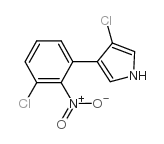| Cas No.: | 1018-71-9 |
| Chemical Name: | Pyrrolnitrin |
| SMILES: | O=[N+](C1=C(Cl)C=CC=C1C2=CNC=C2Cl)[O-] |
| Formula: | C10H6Cl2N2O2 |
| M.Wt: | 257.07 |
| Purity: | >97% |
| Sotrage: | Please store the product under the recommended conditions in the Certificate of Analysis. |
| Description: | Pyrrolnitrin is an antibiotic isolated from Pseudomonas pyrrocinia. Pyrrolnitrin shows a broad spectrum of antibiotic activity against fungi, yeast and gram-positive bacteria[1]. |
| Target: | Target: fungi, yeast and gram-positive bacteria[1] |
| In Vitro: | Pyrrolnitrin (0-100 μg/ml) shows antibiotic activities against various bacteria and fungi with different MIC values. It against Staphylococcus aureus, Mycobacterium, Bacillus subtillis, Candida albicans, Aspergillus niger, and Trichophyton rubrum with MIC values of 50 μg/ml, 100 μg/ml, 0.78 μg/ml, 10 μg/ml, 12.5 μg/ml, and 1 μg/ml, respectively[1]. Pyrrolnitrin (0-100 μg/ml) exhibits antimicrobial effect in a microtitre plate assay. It against Arthrobacter oxydans ATCC 14358, Bacillus coagulans ATCC 7050, Bacillus licheniformis ATCC 14580, Bacillus subtilis ATCC 6051, and Bacillus thuringiensis ATCC 10792 with MIC of 6.25 μg/ml[2]. |
| References: | [1]. K H van Pée, et al. Biosynthesis of Pyrrolnitrin and Other Phenylpyrrole Derivatives by Bacteria. Nat Prod Rep. 2000 Apr;17(2):157-64. [2]. N el-Banna, et al. Pyrrolnitrin From Burkholderia Cepacia: Antibiotic Activity Against Fungi and Novel Activities Against Streptomycetes.J Appl Microbiol. 1998 Jul;85(1):69-78. [3]. R S Gordee, et al.Systemic Antifungal Activity of Pyrrolnitrin.Appl Microbiol. 1969 May;17(5):690-4. |

 To enhance service speed and avoid tariff delays, we've opened a US warehouse. All US orders ship directly from our US facility.
To enhance service speed and avoid tariff delays, we've opened a US warehouse. All US orders ship directly from our US facility.




















